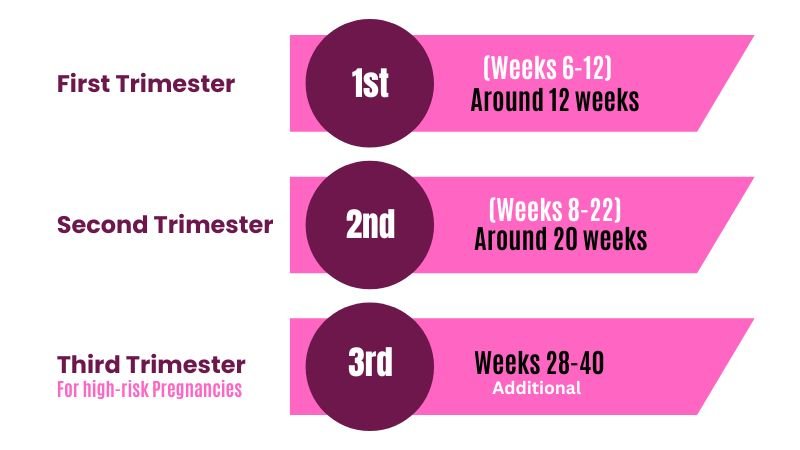Pregnancy is an exciting journey filled with milestones, and one of the most anticipated moments is seeing your baby through an ultrasound, also known as a sonogram. If you’ve ever wondered, “How many sonograms during pregnancy are necessary?”, you’re not alone. The number of ultrasounds you’ll have can vary depending on your healthcare provider, your baby’s needs, and your own health.
In this article, we’ll explore everything you need to know about sonograms with answers to 9 essential questions, including their purpose, safety, and when to expect them. Whether you’re seeking reassurance or planning ahead, understanding how many sonograms are typically performed during pregnancy can help you feel more confident every step of the way.
1. What is a Sonogram?
A sonogram is an image created by an ultrasound, a medical procedure that uses high-frequency sound waves to visualize the inside of the body. In pregnancy, sonograms are used to monitor the baby’s growth and development inside the womb. Although the terms “sonogram” and “ultrasound” are often used interchangeably, they technically refer to different things:
- Ultrasound: The process or technology used to capture the images.
- Sonogram: The image produced by the ultrasound.
In prenatal care, healthcare providers perform ultrasounds to create sonograms, which help track the baby’s health, detect abnormalities, and estimate due dates.
2. Is It True That Pregnancy Ultrasounds Are Dangerous?
No, pregnancy ultrasounds are not dangerous when performed by trained professionals following medical guidelines. The American College of Obstetricians and Gynecologists (ACOG) and the U.S. Food and Drug Administration (FDA) both confirm that ultrasounds are safe for both the mother and baby when used appropriately.

Ultrasounds use sound waves, not radiation, making them much safer than other imaging techniques like X-rays. However, they should only be performed when medically necessary to avoid unnecessary exposure.
Trusted References:
- World Health Organization (WHO): Emphasizes the importance of using ultrasounds judiciously for medical purposes.
- American Institute of Ultrasound in Medicine (AIUM): Regularly reviews ultrasound safety standards and affirms their safety in prenatal care.
3. Standard Ultrasounds Offered in U.S. Hospitals
In the United States, most hospitals and clinics follow a standard ultrasound schedule:
- Dating Ultrasound (6-9 weeks): Confirms pregnancy, estimates the due date, and checks for multiple pregnancies.
- First Trimester Screening (10-14 weeks): Combines ultrasound with blood tests to assess risk for chromosomal abnormalities like Down syndrome.
- Anatomy Scan (18-22 weeks): A detailed scan to evaluate the baby’s organs, measure growth, and check the placenta.
- Third Trimester Growth Scan (28-40 weeks): Performed only if necessary, to monitor growth, amniotic fluid levels, or the baby’s position.
These are the most common scans, but additional ultrasounds may be recommended for high-risk pregnancies.
💡 Related Article: Need an ultrasound but unsure where to go? Does Urgent Care Do Ultrasounds for Pregnancy? 10 Key Insights Every Expecting Parent Should Know breaks down when and where you can get an ultrasound to monitor your baby’s health.
4. Ultrasound Practices Around the World
The number of ultrasounds during pregnancy varies by country, depending on healthcare systems and guidelines. Here’s a comparison:
| Country | Average Number of Ultrasounds | Purpose |
| United States | 2-4 | Standard schedule with additional scans for high-risk pregnancies. |
| United Kingdom | 2 | Dating scan and mid-pregnancy anomaly scan; additional scans for complications. |
| Canada | 2-3 | Routine ultrasounds plus optional scans if concerns arise. |
| Australia | 3 | Early dating scan, anatomy scan, and third-trimester scan if necessary. |
| Germany | 3-4 | Routine ultrasounds covered under public healthcare. |
This variability highlights the importance of personalized prenatal care.
💡 Related Article: Pregnancy often comes with unexpected medical needs, including dental care. If you’re wondering whether it’s safe to undergo dental procedures while pregnant, Can You Have a Root Canal During Pregnancy? 8 Expert Tips for Safe Dental Care provides essential insights on protecting your health and your baby’s well-being.
5. An Overview of Your Ultrasound Schedule
The ultrasound schedule during pregnancy typically follows a structured timeline, with specific scans recommended at different stages. Here’s a detailed breakdown:
First Trimester (Weeks 6-12)
- Purpose:
- Confirm pregnancy and check for multiple pregnancies (e.g., twins).
- Estimate your due date based on the size of the fetus (crown-rump length).
- Detect the baby’s heartbeat, which is usually visible by week 6 or 7.
- Type:
- Early ultrasounds may use a transvaginal probe for clearer images.
- Abdominal ultrasounds are used later in this period if the baby is large enough to view externally.
Second Trimester (Weeks 18-22)
- Purpose:
- Perform a detailed anatomy scan to assess your baby’s development.
- Check the baby’s organs, limbs, and facial features.
- Measure growth parameters like head circumference, abdominal circumference, and femur length.
- Identify the baby’s gender (if desired).
- Assess the placenta’s health and position.
- Type:
- Abdominal ultrasound.
Third Trimester (Weeks 28-40)
- Purpose:
- Monitor the baby’s growth and position (head down, breech, etc.).
- Assess amniotic fluid levels to ensure a healthy environment for the baby.
- Check the placenta for potential issues like placenta previa.
- Confirm the baby’s position closer to delivery.
- Type:
- Abdominal ultrasound.
Note: Third-trimester ultrasounds are not routine for all pregnancies. They are typically recommended for high-risk pregnancies or if complications are suspected.

6. Do You Get 3 Ultrasounds During Pregnancy?
In a low-risk pregnancy, many women receive around three ultrasounds: one in each trimester. However, this is not a fixed rule. Factors like your health history, pregnancy complications, or the healthcare provider’s preferences can increase or decrease the number of scans.
For instance, women with high-risk conditions (e.g., gestational diabetes, hypertension, or carrying multiples) may undergo more frequent ultrasounds.
Let’s Talk: Is ultrasound safe in pregnancy?
7. What Your Ultrasound Can Show
Ultrasounds provide essential insights into your baby’s development, including:
- Confirmation of a healthy heartbeat.
- Measuring the baby’s size and weight.
- Identifying the baby’s position (head down or breech).
- Monitoring the placenta’s health and position.
- Detecting any structural abnormalities early.
💡 Related Article: As your pregnancy progresses, comfort becomes a priority. How to Wear a Pregnancy Belt: 8 Exquisite Tips for Comfort explores how a pregnancy belt can help support your growing belly and ease discomfort during each stage of pregnancy.
8. Before and During an Ultrasound Scan
Before the Scan:
- Early Pregnancy: Drink water before an abdominal ultrasound to ensure a full bladder, which helps create clearer images.
- Later Pregnancy: No special preparation is usually needed.
During the Scan:
- A gel will be applied to your belly for abdominal ultrasounds, and the technician will move the transducer to capture images.
- For transvaginal ultrasounds, the transducer is inserted into the vagina to obtain clearer images of early pregnancy structures.
The procedure is painless, though the pressure from the transducer may cause mild discomfort.
9. Can an Ultrasound Harm Me or My Baby?
Ultrasounds are safe and non-invasive. They do not use radiation and have been extensively studied for their safety in pregnancy. Risks only arise if the procedure is performed unnecessarily or improperly, which is why reputable healthcare providers follow strict safety guidelines.
💡 Related Article: Pregnancy is often accompanied by questions about the safety of medical procedures like ultrasounds. Rest assured, ultrasounds are safe when performed by trained professionals following medical guidelines. Similarly, if you’re dealing with nausea or motion sickness, you might find our guide on ‘Is Dramamine Safe for Pregnancy?’ helpful in addressing medication safety concerns.
Conclusion
Ultrasounds are a cornerstone of modern prenatal care, offering invaluable insights into your baby’s health and development. Knowing what to expect and understanding the purpose of each scan can help you feel more confident throughout your pregnancy journey. Always consult with your healthcare provider for personalized advice about your ultrasound schedule. By following the guidance of trusted organizations like the ACOG and WHO, you can rest assured that ultrasounds are a safe and effective tool in monitoring your baby’s growth.
💡 Related Article: Managing pain during pregnancy can be tricky, especially when it comes to medication safety. Can I Take Excedrin During Pregnancy? 11 Key Points to Decide If It’s Safe for You dives into what you need to know about Excedrin and alternative pain relief options.



